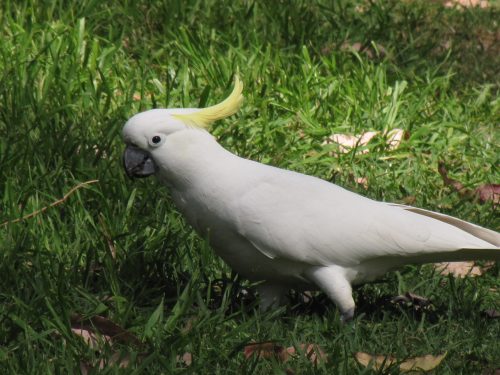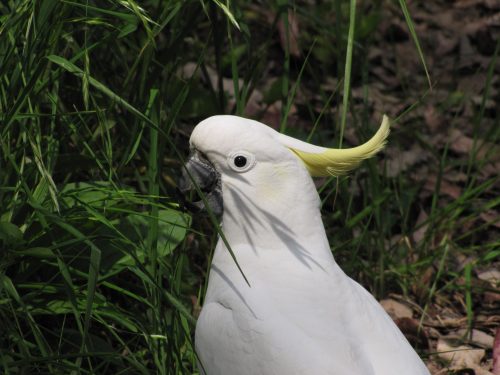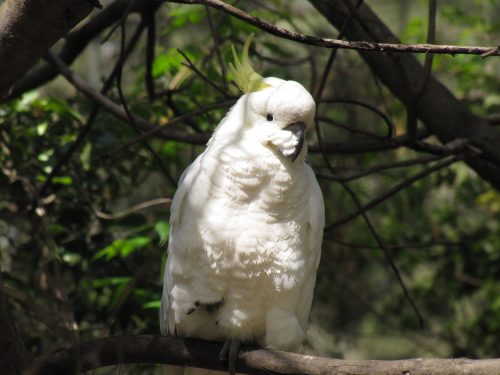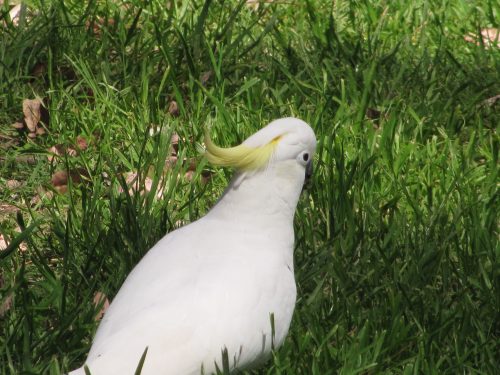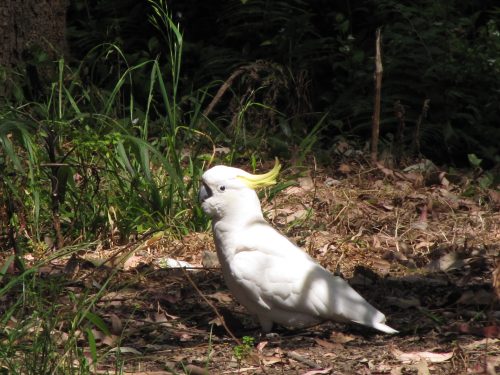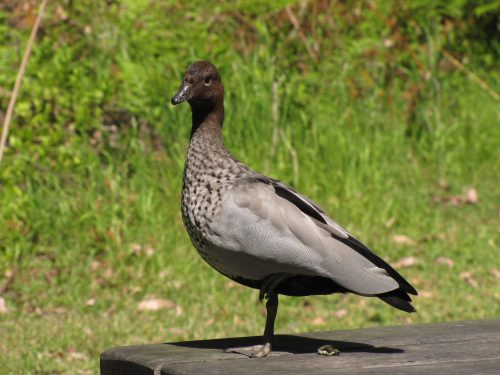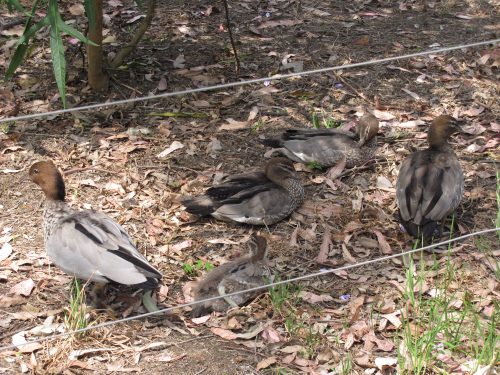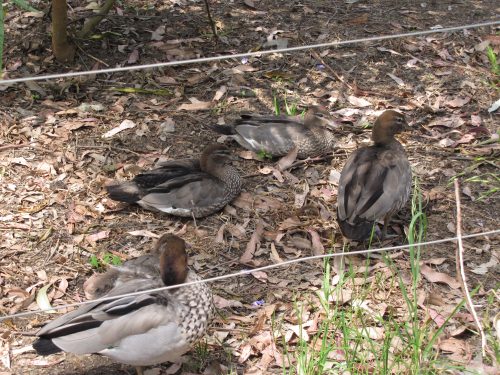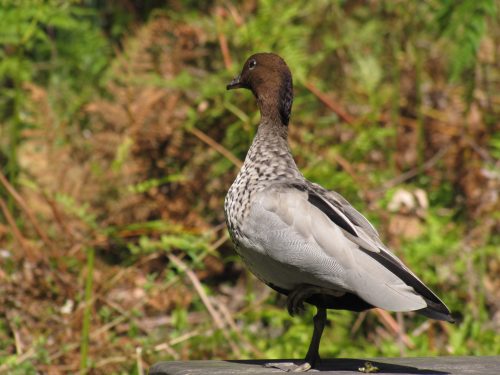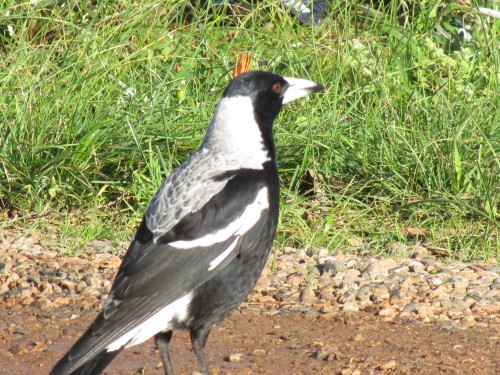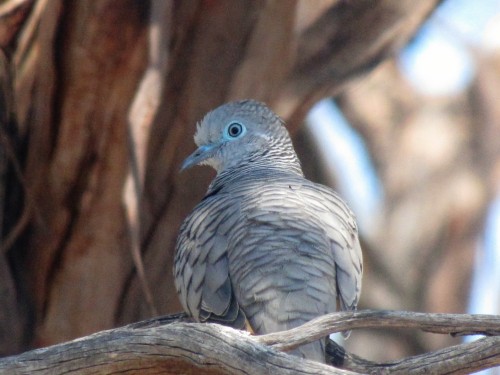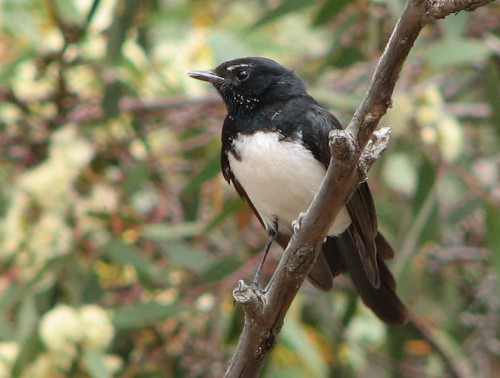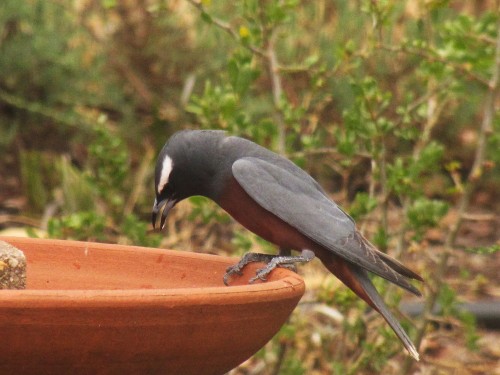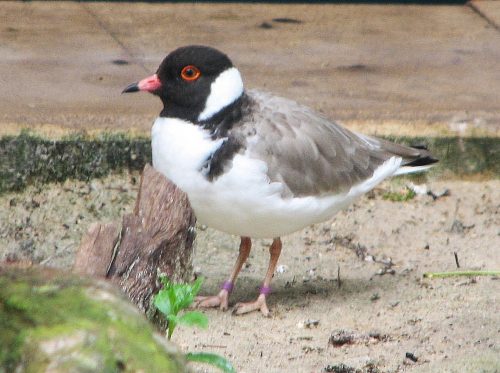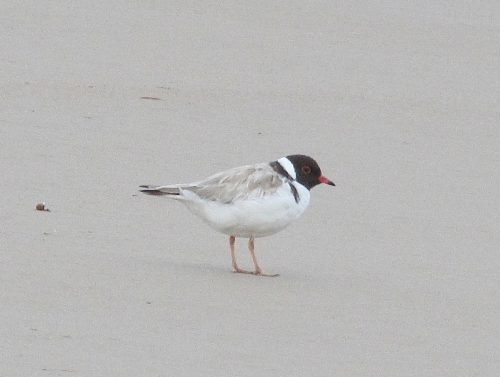Sulphur-crested Cockatoos in Lane Cove
One of Australia’s most recognised and common birds would have to be the Sulphur-crested Cockatoo. I have included a series of photos of this species in this post today. It is found along the north, east and southern coasts of Australia, and in Tasmania. It has been introduced to the south of Western Australia, and in New Zealand.
Large flocks
Throughout its range, it can often be found in large flocks numbering from a few dozen through to many hundreds. In my travels around different parts of Australia, I have observed this species in large numbers, especially where there is an abundance of seed for them to feed on, such as pastures. I have seen large flocks settle in paddocks, making the ground look like snow has fallen. When a flock is feeding on the ground, one or more birds will perch in a tree or on a fence post watching out for any danger. A large flock can also add colour to a dull grey looking gum tree when they all perch together.
Noisy birds
These birds have a very raucous call, and when a flock flies low overhead while calling, it is very hard to carry on a conversation. In some caravan parks we have stayed in where this bird is resident, a noisy flock can be an unwelcome alarm clock, particularly at first light when one wants to sleep in a little. In populated areas, this beautiful bird is often regarded as an unwelcome pest. With such an abundance of food, cockatoos can easily get bored and start chewing on timber work around houses and other buildings. Some of my readers have complained in the past about the destructive nature of this species. There is no easy solution to this problem because this species is a protected bird, like all of our native birds. If you are having a problem with cockatoos, please be in contact with your local National Parks and Wildlife office. It is an offence to destroy them.
Good pets
This species is also a common, long-lived pet for many people. They can be delightful pets and will often learn a range of words and phrases to mimic their owners. I am not familiar with the current regulations on keeping our native birds as pets, so it is best to talk to your local pet shop owners before buying a cockatoo as a pet. They are probably commonly available in pet shops in countries other than Australia. There should be no restrictions on keeping them outside of Australia.
The photos in today’s post were all taken of an individual in the Lane Cove National Park in Sydney. we were staying with our son spending time with our grandchildren during school holidays. On this occasion, we had a few hours break from the children, so we packed a picnic lunch and drove the short distance to the national park. Along the Lane Cove River, there are many lovely grassed picnic areas, complete with picnic tables and gas barbeques for the public to use.
Corellas v Cockatoos
Some people can easily be confused when trying to identify cockatoos and corellas. The three species of corellas in Australia are the Little Corella, Long-billed Corella and the Western Corella. Their ranges often overlap. I have even seen mixed flocks consisting of two species. Corellas are generally a little smaller and all corellas lack the yellow crest of the Sulphur-crested Cockatoos. The calls are also different, with the corellas’ calls being not as loud or as harsh.
Further reading:
- Sulphur-crested Cockatoos up close
- Red-tailed Black-cockatoos
- Gang-gang Cockatoos
- Great Birding Moments #13
- Trevor’s Photos – buy some of my photos on a variety of products such as mugs, place mats, t-shirts and many more.
- Little Corellas at Mannum
- Long-billed Corellas
Ducks in Lane Cove National Park
On our most recent trip to Sydney in October, we were primarily there to look after our two grandchildren (ages 8 and 5) during the school holidays. This is a very pleasant duty we enjoy several times a year. They are, however, very energetic children and so there comes a time during our stay when we look for opportunities to have some down time.
Thankfully, my son’s home is only a short drive to some very pleasant parks, including Lane Cove National Park, a mere ten-minute drive away – subject to traffic conditions, of course. On several occasions, we had a few hours to ourselves, so we packed the folding chairs, a picnic lunch, a thermos for a cuppa and some biscuits. I always remembered to take my binoculars and camera with as well.
At one point I noticed a small family of Australian Wood Ducks grazing on the grass near where we had our chairs located. I grabbed my camera and managed a few nice shots of them. At one point, the male of the group stood guard on one of the picnic tables (see photo at top). He was obviously keeping watch over his little family of three young ones.
Although the male was on guard, he didn’t seem all that perturbed that I had approached to within a few metres to take my photos. This national park is very popular, and there are hundreds of visitors daily and probably thousands every weekend, seeing it is so close to the well-populated Chatswood CBD. I have found other species equally unafraid of humans, including some Laughing Kookaburras who snatched some of my wife’s lunch the same day I took the photos on this post. (In a few days I will post an article, with photos of this incident.)
I should add here that this is the Australian Wood Duck, not to be confused with the Wood Duck, a north American species, and quite unrelated as far as I know.
The Australian Wood Duck is a common species found throughout much of Australia, except for the driest parts of the inland. It is usually found near waterways, lakes, swamps and dams, and in parks and ovals, but it also can be see grazing on grasses and pastures quite some distance from water.
Newsletter: just a reminder that I will be starting a monthly newsletter in the New Year. You can subscribe below the comments section at the bottom of each article.
Further reading:
Happy Christmas
HAPPY CHRISTMAS to all of my readers.
I watched the news this evening and saw that terrible weather conditions are being experienced by many people around the world. From storms, heavy rain, blizzards, to deep snow and heat waves. Our own South Australian capital city, Adelaide, had the highest temperature of all the cities of the world: 41.3C (106F). I live only 80km south east of Adelaide and it was very hot here too – around the same temperature; it may have just touched 42 for a while. Except for a trip to church early in morning, I stayed indoors in air-conditioned comfort. Thankfully, cooler weather and rain is forecast for later in the week.
Birds in hot weather
Yesterday I wrote about the importance of regularly providing fresh water for the birds in your garden, especially in the type of hot weather we experience in summer here in Australia. They really appreciate it, and this provides opportunities for the avid birder to watch them through a nearby window without disturbing them in any way.
Because of the hot weather, I was reluctant to get out and about. Despite the heat, I was aware of some of the species outside. Some of our birds have loud calls, and we had a very quiet Christmas with no visitors. Several times I heard Peaceful Doves calling, and there was the persistent call of a baby Red Wattlebird just out of the nest. Through one of our windows I saw our resident Willie Wagtails a few times, and this evening, when I briefly braved the elements, I disturbed a small flock of Galahs from one of our trees.
The resident Australian Magpies came frequently for a drink at the bird bath, and earlier this morning I observed a loose flock of about 25 Little Ravens flying overhead. The resident House Sparrows kept in the shade for most of the day, coming to the water in the birdbaths frequently. We usually hear the noisy and gregarious New Holland Honeyeaters, but they were rather subdued today. So were the Spiny-cheeked Honeyeaters and the White-plumed Honeyeaters. I also briefly heard the small family of Superb Fairy-wrens which occupy the bushy parts of our property.
I just checked the weather radar; there are storms on the way. Tomorrow I must get outside a few times and keep a look out for Swifts; just their kind of conditions.
Once the weather cools a little, I hope to get out and about a few times. It is about time I took some more photos to share here.
In the meantime, I hope that you have a wonderful Christmas wherever you are, and whatever the weather.
Good birding,
Trevor
Give the birds a drink
It has been a year of great weather contrasts this year in South Australia, and in other parts of the country too. At various times it has been freezing cold, fiery hot, bucketing with rain, wild storms and everything in between. We have also had the occasional beautiful day as well. Our state has had terrible bushfires, devastating floods, power blackouts from storms, crop damage due to large hail and silently creeping frosts.
Now we are about to feel the full force of summer weather. Christmas Day tomorrow promises temperatures in the low 40s (40C = 104F). In fact. our capital city Adelaide is forecast to be the hottest capital city in the world on Christmas Day. Still, at this time of the year, we expect some days in the 40s and many days in the 30s.
Heat and birds
The heat can adversely affect our birdlife here in Australia. One of the best things people can do in these hot conditions is to put out clean water for the birds. I have several birdbaths dedicated to the birds in our garden. A constant stream of birds come to have a bath or a drink on hot days. Even on mild days, the bowls are very popular.
Place the bird bath in a shady location near to a tree or bush. This can help protect the smaller species from birds of prey; it gives them a place to escape. It can be on the ground but is better if it is elevated a little. This will give the birds a clear view of any approaching cats.
Try to remember to clean the bird bath regularly, and during our hot weather this summer, top it up every day.
Photography
I have found over many years that having a bird bath near a window makes it easy to get good photographs of the birds while they are drinking or bathing. My wife and I find it very relaxing sitting in a cool room on a hot day, watching the parade of birds coming to drink.
Further reading:
- Time for a bath – a list of birds and animals we have observed at our bird baths
- The importance of bird baths – another article about bird baths
Good birding,
Trevor
An appeal to save our Hooded Plovers
Here in South Australia, there has been some interest generated in the media in recent weeks about the plight of the Hooded Plover. A pair of this species was found to be nesting on one of our popular beaches. There was much concern over protecting the eggs from damage or predation.
This tiny bird is widespread along the coast of South Australia and all of southern Australia, including Tasmania. Nowhere is it common, and everywhere it is threatened. It is estimated that fewer than 2500 of these lovely birds exist. And during the summer months, when they nesting, they are most vulnerable.
During the summer months, when they nesting, they are most vulnerable. They make their nest by making a small depression in the beach sand. In this hollow, they lay and hatch their eggs. Surveys have shown that as few as only 2.5% of eggs actually make it to adulthood. That is a shocking statistic; it is NOT a typo.
The eggs can be damaged in many ways:
- The eggs can be trampled on by people, dogs, horses or vehicles (we still have some beaches with car access here in South Australia – all in Hooded Plover nesting areas).
- Overheating when the eggs are exposed to the burning sun after the adult is scared from the nest.
- Eggs left too long and becoming too cold without the warmth of the adult sitting. This also happens when the adult is chased from the nest by the presence of humans, dogs, and other animals.
- The eggs can also be taken by predators such as foxes, cats, ravens, magpies, gulls and eagles.
If the eggs survive to hatch, the young can die:
- By being run over by vehicles, or stepped on by humans.
- Eaten by predators like foxes, cats, and birds of prey.
What you can do
You may be thinking that you can’t do much to save these, and other, threatened birds.
Think again.
Just by being aware of our wildlife when you go to the beach this summer, and drawing the plight of birds like the Hooded Plover to the attention of family, friends and other beach goers, you can do your bit to save them for future generations.
Donate
I don’t often make appeals for money on this site; in fact, I am sure I have never done so. This is different. Birdlife Australia is running a special appeal for these little birds this summer. You can donate here.
Become a Member
Why not become a member of Birdlife Australia? I have been a member for many decades. They pour large amounts of money into bird conservation, advocacy and research. Membership also provides you with discounts on a range of products and services, and you get their colourful quarterly magazine as well. You can join here.
Further reading:
Good birding,
Trevor
